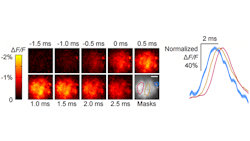Fluorescent Proteins Stimulate Action-Potential Mapping between Neurons
A novel brain-function monitoring technique developed by researchers at the Department of Biomedical Engineering at Duke records action potentials during brain activity. The method involves genetically altered proteins that bind to receptors in brain cells. When coupled with fluorescent proteins to amplify their response, these biosensors react to action potentials with a temporal resolution of 0.2 ms, fast enough to generate a precise picture of the intricate signals generated across neurons during brain functions in mammals.
The sensing proteins are obtained from algae and coupled with fluorescent proteins that amplify their response to action potentials with a minuscule lag time. In the presence of an action potential, the sensing protein absorbs some of the energy released by the fluorescent protein. In turn, when action potentials fire across neurons, a reduction in fluorescence is recorded to accurately depict the magnitude of action potentials across neurons.
The biosensors were tested in the brains of mice and implemented in the cells through the use of a virus. They were also tested in fruit flies. A surprising characteristic of the technique was its ability to read voltage drops generated by different sub-compartments of neurons such as individual dendrites. The study also recorded the features of voltage propagation between neurons. The research team expects this technique to be highly useful in coding algorithms for different brain functions.
The report, “High-speed recording of neural spikes in awake mice and flies with a fluorescent voltage sensor,” was published in Science Express on November 20, 2015. (DOI: 10.1126/science.aab0810)
About the Author
Leah Scully
Associate Content Producer
Leah Scully is a graduate of The College of New Jersey. She has a BS degree in Biomedical Engineering with a mechanical specialization. Leah is responsible for Machine Design’s news items that cover industry trends, research, and applied science and engineering, along with product galleries. Visit her on Facebook, or view her profile on LinkedIn.

